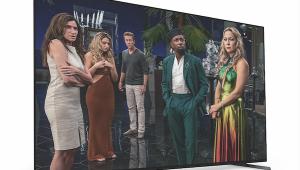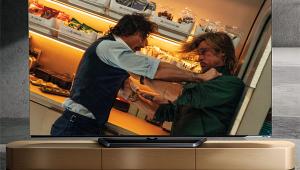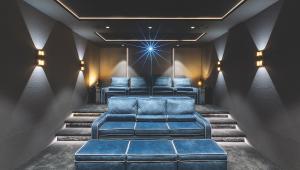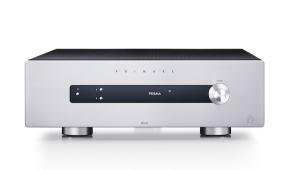LG OLED65C3 4K OLED TV review

 While LG's latest C series mid-range OLED flatscreen is predictably very good, it's left
John Archer wanting a little bit more
While LG's latest C series mid-range OLED flatscreen is predictably very good, it's left
John Archer wanting a little bit more
For years now the combination of value, features and performance offered by LG's mid-range C Series TVs has seen them dominate the OLED market. Yet this year's OLED65C3 arguably doesn't have quite the same allure.
Why? Well, the introduction of Micro Lens Array (MLA) technology to LG's step-up G3 OLEDs has transformed our OLED expectations, but the C3 lineup is an MLA-free zone. Also, perhaps because LG has been focusing so hard this year on the G3 models, the OLED65C3 only delivers – on paper, anyway – some minor advances over its C2 predecessor.
A nip here, a tuck there
Trying to pin down the ways in which the OLED65C3 differs from its 65C2 predecessor starts with the design. This enjoys crisper lines where its ultra-slim outer edges meet a chunkier mid-section, introduces some welcome new cable management, and adopts an even lighter carbon fibre chassis.
Internally, the TV features the same Evo panel without a heat sink of the C2 series, meaning brightness only carries a marginal increase of around 3 per cent or so according to my measurements. There is a new (sixth) generation of LG's Alpha 9 processor, though, which chiefly improves over its predecessor with some new AI Picture Pro features. AI 'Super Scaling' is claimed to increase resolution and sharpness while reducing noise when upscaling sub-4K sources. AI Genre/Scene detection recognises different types of image content to help the TV select the most effective image settings. New dynamic tone mapping algorithms divide the picture up into 20,000 separate analysis blocks. Lastly, improved AI object analysis applies better localised sharpness and HDR enhancements to images.
These new features offer clear improvements over the C2 TV with content that can take advantage of them. Unfortunately, however, the AI Picture Pro processor only works on content that doesn't carry copy protection, which immediately eliminates most video streaming services and external sources (including Blu-ray and 4K Blu-ray players).
Weaving a Web
The 2023 implementation of LG's WebOS smart interface reduces the home 'screen' to just two scrolling pages, letting it run more slickly, and introduces themed folders to house those apps that cluttered up the previous,
longer home page. Picture and sound menus also now default to a small and customisable set of the most-
used features, with the full suite of adjustments having to be separately accessed. This two-tier approach works well if you take the time to set the first layer up to your personal satisfaction.
The OLED65C3's key differences with the C2 conclude with a couple of fresh audio features for the 40W, 2.2-channel speaker system: upconversion of audio tracks to a virtual 9.1.2 soundstage (versus 7.1.2 on last year's set); and a WOW Orchestra feature that lets the TV's speakers unite with those in recent LG soundbars, as well as letting the soundbar benefit from the TV's audio processing.
Sound matters
Having mentioned the OLED65C3's claimed audio improvements, let's kick off with the Dolby Atmos soundtrack of the glamorous but morally bankrupt Passengers on 4K BD. During the film's explosive 'redeeming the selfish hero' climax, the TV's default Atmos setting lacks impact and scale, doesn't project forwards (although there is a decent sense of width) and hints at a rather rough, forced approach to deep bass that becomes more obvious during famously low-end-heavy scenes like 1917's No Man's Land crossing sequence (4K BD).
generation Quantum Dot OLED screens will only arrive later this year in the form of its A95L series. In fact, the 65A80L – also sold under A83L and A84L variants at specific retailers – doesn't even pack a heat sink to help
it deliver more brightness.
It does feature heat-mapping software to optimise how its OLED panel distributes power (and thus light), and my tests found the TV delivering around 10 per cent more light regards both peak brightness and fullscreen brightness than its A80K predecessor. But there's no getting around the fact that a measurement of just under 800 nits on a 10 per cent white HDR test window is only slightly more than half as measurably bright as the latest MLA-based LG G3 and QD OLED-based Samsung S95C models.
Of course, the 65A80L is more affordable than those flagship rivals, its £2,999 launch ticket bringing a saving of £500/£600 on the LG G3/Samsung S95C models respectively. While that's enough of a gap to put it into a whole different market, it's one that's still premium, so Sony specifies the 65A80L with the latest version of it Cognitive Processor XR – a chipset that's delivered such impressive results in previous iterations that it's clearly influenced the latest picture processing systems of most of its TV rivals – and its unique Acoustic Surface Audio innovation, where the TV's screen emits most of its sound.
Google-eyed
Smart features are supplied, as ever with Sony TVs, by the Google TV platform, supported by YouView to cover Google's blind spot with one or two UK terrestrial TV services. All the main streaming options are therefore covered, including BBC iPlayer, Apple TV, Prime Video, Netflix and Disney+, with the latter app finally supporting Dolby Atmos sound through Google TV. Sony's own Bravia Core streaming service, which offers far higher bitrates than other SVOD platforms, is also present and correct, and comes with 10 free 'premium' movie downloads.
The 65A80L is also certified IMAX Enhanced, adding to its support for Dolby Vision HDR alongside the vanilla HDR10 and HLG high dynamic range formats. For me, then, the main disappointment with this TV's features and specifications isn't the conventional OLED panel configuration, but the absence of HDR10+ playback, and a slightly limited HDMI stage. Only two of the 65A80L's four HDMI ports carry 4K/120Hz and VRR feeds from PS5, Xbox Series X and PC hardware, and you can't have both Dolby Vision and 4K/120Hz simultaneously through even the two high-capacity HDMIs, either.
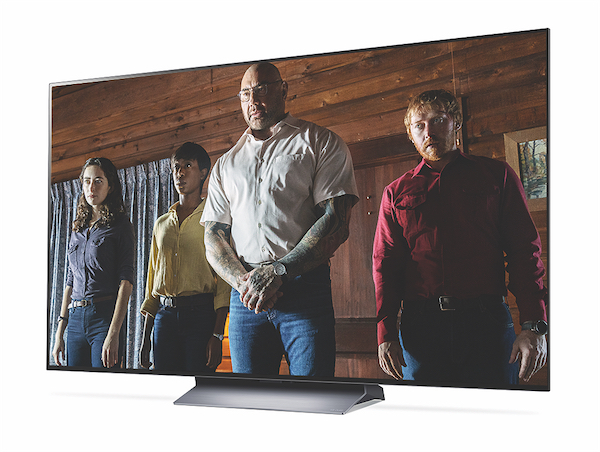
It's down to LG's AI Sound Pro system to generate a much louder, more aggressive, more room-filling sound that enjoys greater overt sound effect placement and steering. The virtual 9.1.2 remix delivers a remarkably large, 3D-sounding soundstage too, although it can be unbalanced, causing male voices to sound rather 'soupy' and bass to flit between being too dominant at some levels and strangely losing impact at others.
As expected, with copy protected content of the sort HCC readers will be keen to watch, the OLED65C3's pictures only deliver an incremental improvement over 2022's C2s. The endless artificial light sources that illuminate the stunning 4K image of Passengers look slightly brighter, while the fullscreen bright shots of the white main passenger deck appear marginally lighter.
The C3's colours also seem to have gained an edge in saturation, as evidenced by the depiction of the spaceship's relatively 'warm' bar area. But that's about it.
It's actually more illuminating to compare the OLED65C3's pictures with those of other-brand TVs, including the Sony 65A80L. This confirms, for instance, that LG isn't going as far in bringing out the tiny details and subtleties of 4K images, something useful in enhancing the feeling of depth in Passengers' long corridors and large communal spaces. Sony's rival set also handles motion and camera pans more naturally.
For its part, LG's 65-incher serves up visibly and measurably more HDR brightness with Passengers' brightly lit interiors – both peak and fullscreen. Its colours are more vibrant, and, surprisingly, head-to-head comparisons during very dark scenes in other movies revealed the OLED65C3 capable of producing subjectively deeper black levels, if not the same level of shadow detail.
During my audition I encountered a quite strange issue with the TV's Filmmaker Mode, where some mostly bright HDR shots (such as the swirling clouds outside Sapper Morton's house around five minutes into the 4K Blu-ray of Blade Runner 2049) suffer with quite severe clipping and colour banding.
The OLED65G3 is a stunning option for video gamers, thanks to all four of its HDMIs being to the v2.1 specification. Variable refresh rate handling includes Nvidia G-Sync and AMD FreeSync, and there's even support for Dolby Vision at 4K/120Hz. The TV's fastest measured input lag time of 9.1ms is also as good as it gets. Don't need a 65in TV to play Hogwarts Legacy? LG also sells its C3 range at sizes down to 42in.
Reality check
Pulling all my findings together, it's impossible to ignore a touch of disappointment that the OLED65C3 doesn't improve more over its predecessor, and so doesn't get closer to the magnificence of LG's new MLA-based G3.
It does, however slightly, improve on what was an absolute OLED superstar only 12 short months ago, so wishing LG could perhaps have tried a bit harder here shouldn't blind us to the fact that, in reality, it's still another fantastic OLED TV from the brand. Highly recommended, unless you're looking for a serious upgrade on your 2022 C2 model!
HCC Verdict: 4.5/5
LG OLED65C3
Price: £2,899
www.lg.com
We say: While it's only a marginal improvement on its predecessor and is rather eclipsed by its mighty G3 siblings, the OLED65C3 still classes as an outstanding TV for its money.
Specifications
4K: Yes. 3,840 x 2,160 HDR: Yes. HDR10, HLG, Dolby Vision TUNER: Yes. Freeview HD; satellite HD CONNECTIONS: 4 x HDMI inputs; 3 x USB; Ethernet; optical digital audio output 4K/120 PLAYBACK: Yes SOUND (CLAIMED): 2.2-channel, 40W BRIGHTNESS (CLAIMED): N/A Contrast: N/A DIMENSIONS: 1,441(w) x 826(h) x 45.1(d)mm WEIGHT: 16.6kg
FEATURES: Wi-Fi; Bluetooth; Alpha 9 Generation 6 processing engine; WebOS smart system; Game Dashboard for easy access to gaming features; VRR incl. Nvidia G-Sync and AMD FreeSync; HGiG mode; Auto Low Latency Mode switching; 4K/120Hz Dolby Vision; WOW Orchestra; virtual 9.1.2 audio upmixing; Evo panel
 |
Home Cinema Choice #351 is on sale now, featuring: Samsung S95D flagship OLED TV; Ascendo loudspeakers; Pioneer VSA-LX805 AV receiver; UST projector roundup; 2024’s summer movies; Conan 4K; and more
|













